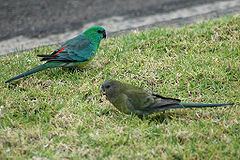A broad-tailed parrot is any of about 35–40 species belonging to the tribe Platycercini. The members of the tribe are small to medium in size, and all are native to Australasia, Australia in particular, but also New Zealand, New Caledonia, and nearby islands.
Genus ProsopeiaCrimson shining parrot, Prosopeia splendensMasked shining parrot, Prosopeia personataMaroon shining parrot, Prosopeia tabuensisGenus EunymphicusHorned parakeet, Eunymphicus cornutusOuvea parakeet, Eunymphicus uvaeensisGenus CyanoramphusBlack-fronted parakeet, Cyanoramphus zealandicus†Society parakeet, Cyanoramphus ulietanus†Antipodes parakeet, Cyanoramphus unicolorRed-crowned parakeet, Cyanoramphus novaezelandiaeMacquarie parakeet, Cyanoramphus erythrotis†Reischek's parakeet, Cyanoramphus hochstetteriYellow-crowned parakeet, Cyanoramphus auricepsChatham parakeet, Cyanoramphus forbesiMalherbe's parakeet, Cyanoramphus malherbiNew Caledonian parakeet C. saissetiNorfolk parakeet C. cookiGenus PlatycercusWestern rosella, Platycercus icterotisCrimson rosella, Platycercus elegansAdelaide rosella, Platycercus (elegans) adelaidaeYellow rosella, Platycercus (elegans) flaveolusGreen rosella, Platycercus caledonicusPale-headed rosella, Platycercus adscitusEastern rosella, Platycercus eximiusNorthern rosella, Platycercus venustusGenus Barnardius - sometimes included in PlatycercusAustralian ringneck, Barnardius zonariusGenus PurpureicephalusRed-capped parrot, Purpureicephalus spuriusGenus LathamusSwift parrot, Lathamus discolorGenus Northiella - often included in PsephotusEastern bluebonnet, Northiella haematogasterNaretha bluebonnet, Northiella narethaeGenus PsephotusRed-rumped parrot, Psephotus haematonotusMulga parrot, Psephotus variusGolden-shouldered parrot, Psephotus chrysoptergiusHooded parrot, Psephotus dissimilisParadise parrot, Psephotus pulcherrimus (extinct, late 1920s)The budgerigar was traditionally placed in this tribe, but this inclusion is incorrect. The closest relatives of the budgerigar are the lories and lorikeets. The genera Neopsephotus, Neophema, and Pezoporus are placed in a separate, but closely related tribe, the Pezoporini based on the paper by Joseph et al. (2011)

